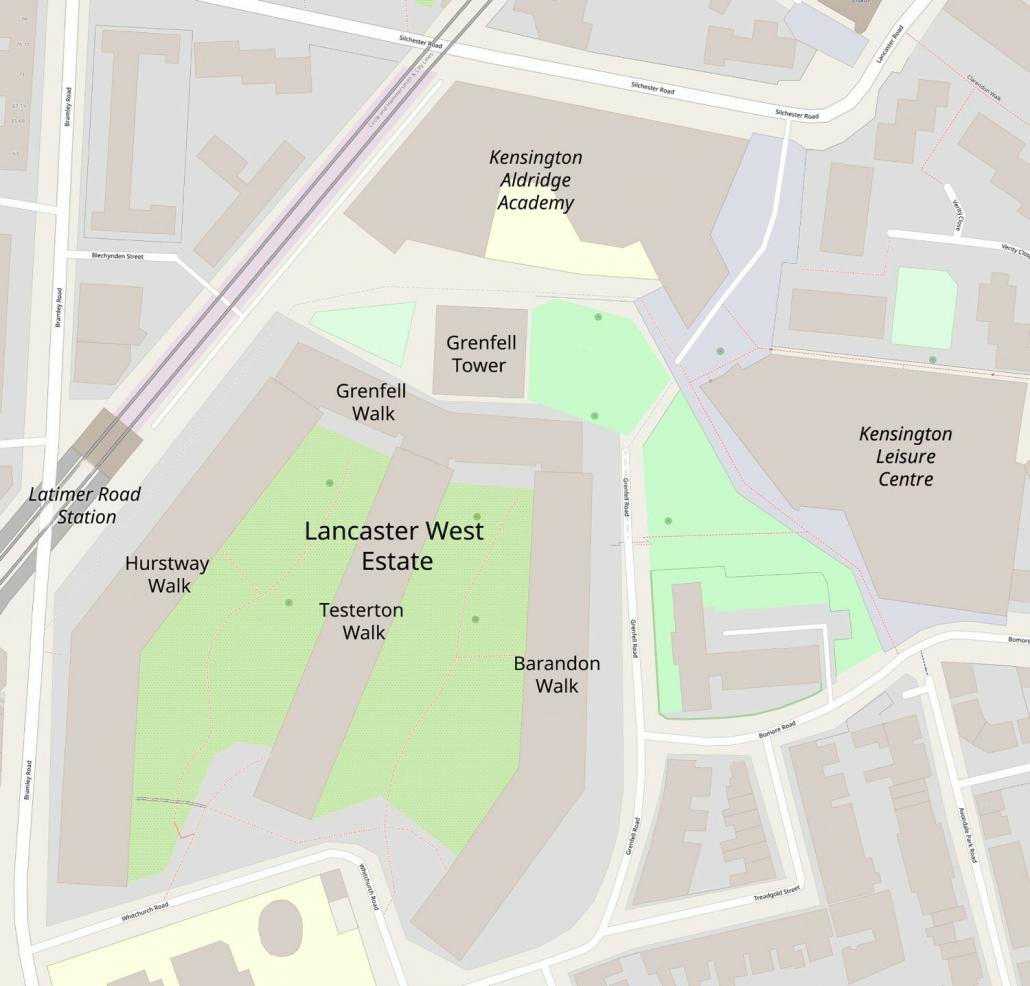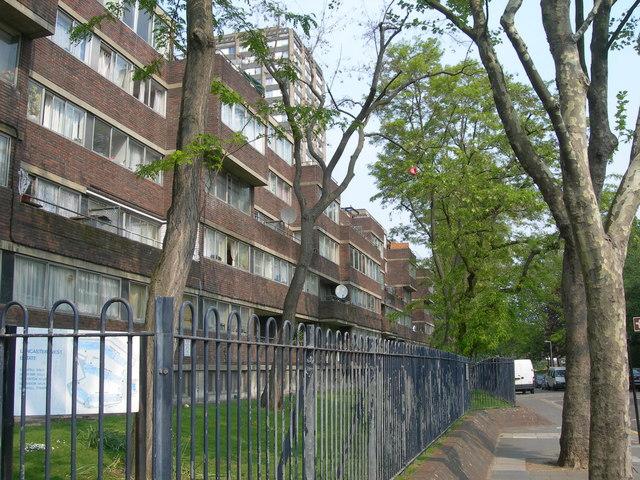Opinion: Grenfell – not one but multiple stories of displacement
Sharda Rozena is a PhD researcher in the field of human geography studying gentrification in her home borough of Kensington. She has published an article on displacement on Lancaster West Estate.
Posted:
Time to read:
The combustible cladding installed on Grenfell Tower was part of an estate regeneration plan proposed by the Royal Borough of Kensington and Chelsea (RBKC). The cladding served an aesthetic function; to make low-income (mostly social rent) housing look better for the super-rich living nearby. Professor Loretta Lees (2014) writes that estate regeneration schemes are built under the guise of creating ‘mixed-income’ communities, but that they ultimately reduce social housing, increase the cost of liveability, transform the socio-economic character of the area, and displace low-income communities. In short, they result in gentrification.
I interviewed residents and councillors in Kensington and Chelsea; including three in-depth interviews with Lancaster West Estate residents (Catalina, Amara and Ali) who described their experience before, during, and after the Grenfell fire. Their responses support the view that estate regeneration led to multiple experiences of displacement (see also Bale).

Sociologist Ruth Glass, who coined the term gentrification in 1964, described how in North Kensington the poorest were ‘wedged in between newcomers who were more prosperous’, and this competition for space led to the displacement of the working class. From the 1990s, wealthy middle-class residents moved into North Kensington, house prices increased, and facilities materialised to cater to them; Catalina referred to a ‘frozen yoghurt place’ that was symptomatic of this. RBKC also redeveloped the local leisure centre near the Estate. Amara discussed the increasing prices: ‘we used to go swimming for like £1.50, now you have to pay £5.’ The affluent areas surrounding the Lancaster West Estate (where Grenfell Tower is situated) partially explain the impetus behind ‘regeneration’. A planning application stated that ‘the changes to the existing tower will improve its appearance especially when viewed from the surrounding area.’ Catalina explained, ‘it feels like slowly the poor side is completely invisible to the point that when you tell people you’re from this area, they say you’re rich and I’m like no! You feel a bit disconnected from it all because you know it’s not really there for you.’ This exclusionism - making residents feel rejected from local commercial and social spaces – is a form of displacement.
State-led gentrification involved the destruction of public space around the Estate. Amara said: ‘before they gentrified Grenfell Tower, we had three football pitches and Ali [her brother] would always play football with his friends there.’ Known locally as Green Pitch, this public space had long been a valued community asset. The regeneration scheme saw the Kensington Aldridge Academy built over it. Catalina said: ‘a lot of people were sad about Green Pitch going, that the history of it would go and I guess estate life, it’s easier to fall into bad behaviour and having a nice football pitch to hang out was good.’ Green Pitch gave young people dedicated space to play, exercise and socialise – in many ways a second home. Yet RBKC deemed the space worth destroying. This, I argue, demonstrates a ‘sink estate’ attitude on the part of the Council: as the estate was seen as ‘ugly’, it had no compunction about removing its amenities until it could be condemned. After years or mismanagement and the neglect of tenants, in 2009 RBKC called for the demolition of Grenfell Tower stating that the appearance ‘blights’ the surrounding area.

© OPENSTREETMAP CONTRIBUTORS LICENSED UNDER THE CREATIVE COMMONS ATTRIBUTION-SHAREALIKE
Thus, neglect was something commonly felt among residents even before the refurbishment. There were concerns about fire and safety regulations in Grenfell Tower. Amara recalled the danger of uncovered gas pipes and Catalina explained, ‘the council really doesn’t care. We always had jokes like “oh we have this leak in our house, that’s never going to be fixed!”’ The neglect shown towards basic repairs is a common symptom of the managed decline of council estates. Catalina said, ‘it’s still on deaf ears, the actual concerns that people have, there's a massive hallway in-between all the houses and they started revamping that up to make it “nice” and it’s like why? I think people care more about the quality of their houses rather than the appearance of a walkway.’ Willis (2018) reports similar findings when Oxford City Council refurbished tower blocks: the aesthetic improvements were external, while interiors continued to have major internal issues including leaking pipes, floods, and large, noisy ventilation systems.
The focus on appearance over functionality was devastatingly revealed in the lethality of Grenfell Tower’s council-approved cladding.
Amara said, ‘I remember fire trucks and just seeing loads of people from Grenfell Tower running out, those that could escape, the survivors… some of them had kids on their backs, some of them were just running, crying, screaming.’ Ali described ‘ash on our balcony the next day.’ After the fire, Amara said it was like ‘living next to a graveyard’ and their younger siblings had recurrent nightmares after seeing their neighbours die. The trauma of the fire led to Ali and Amara’s family moving elsewhere.
Lees and White state that ‘displacement is rarely a singular move.’ Indeed, Ali and Amara were moved three times over three years while waiting for a council home. Ali described the last apartment they stayed in as ‘bloody nice… we kinda got used to it’, but after a year RBKC demanded they pay market rent. ‘We couldn’t afford it’ said Ali, ‘it was… maybe four times our [council] rent.’ They were eventually rehomed permanently on World’s End Estate in Chelsea, but the family continue to pay off the debt accrued from their time living in the ‘nice’ apartment.

DANNY ROBINSON, CC BY-SA 2.0 VIA WIKIMEDIA COMMONS
Social divisions can also be seen in the political representation of RBKC, with Labour councillors representing the north and Conservatives the south. These divisions were evident when interviewing Conservative councillors. In a very transactional statement, one councillor said: ‘we lost 2 and a half percent of our housing stock in one building in that Tower.’ Another celebrated their new deputy leader’s business approach: ‘Kim Taylor-Smith has been an asset for Grenfell’ because he found a ‘whole block’ for Grenfell survivors.’ They talked about social housing in terms of percentages, units or ‘blocks.’ Even after the fire, institutional indifference towards council tenants was reflected in their comments. A councillor told me that the tower block had not been ‘particularly pretty without cladding’ and he was unsure about who had lived there: ‘I don’t know whether that was mixed, the kinds of people, I don’t know, I didn’t ask anybody.’ This commentary from many Conservative councillors was unsympathetic and there was no discussion of their accountability. At the time of the interviews, we knew about the failings of RBKC and the neglect and contempt that residents were met with. But calling tower blocks ‘ugly’ and ‘undesirable places to live’, as another councillor described them, shows the continuation of a ‘sink estate’ rhetoric that attempts to legitimise the demolition of social housing on the grounds that they are unpleasant places to live. Residents of Lancaster West told a different story on the appearance of their homes: ‘Grenfell had a new coat and alright it looked nice, but it wasn’t necessary by any means, no one walked past it and went that’s a fucking ugly building.’ Catalina said ‘if you asked anyone, no one gives a shit what the building looked like, it was just a building. It’s functional.’
Many residents expressed how RBKC still wants to remove working-class people from the area; as Bale (2021) describes it: ‘a deliberate attempt to cleanse these areas of those who are deemed surplus.’ Catalina stated, ‘I’m very proud of being from an Estate but at the same time it’s hard when you do grow up with really big evidence that the council really doesn’t care about you.’ As for Ali and Amara, they are in the process of making a permanent home elsewhere. Ali explained that all he wanted is for his new home to be safe and removed from the consequences of state-enforced gentrification: ‘What I don’t want is there to be a brand-new leisure centre that no one can afford to go to… it removes the culture out of the area.’ Social housing is declining at an astonishing rate in the UK because of estate regenerations. Residents at the Lancaster West Estate talked about ongoing experiences of displacement, fuelled by state-led gentrification via estate regeneration. The Grenfell Tower fire was a part of structural processes of negligence that forced a ‘sink estate’ discourse onto the Estate and undermined the needs and concerns of residents. The regeneration of Lancaster West Estate is arguably the worst chapter of Britain’s housing crisis, and has exposed how the most atrocious physical and emotional violence is inflicted on council tenants when local and national authorities put profits and appearances before people and their homes.
How to cite this blog post (Harvard style):
S. Rozena. (2022) Opinion: Grenfell – not one but multiple stories of displacement. Available at:https://blogs.law.ox.ac.uk/housing-after-grenfell-blog/blog-post/2022/06/opinion-grenfell-not-one-multiple-stories. Accessed on: 15/01/2026Share:
